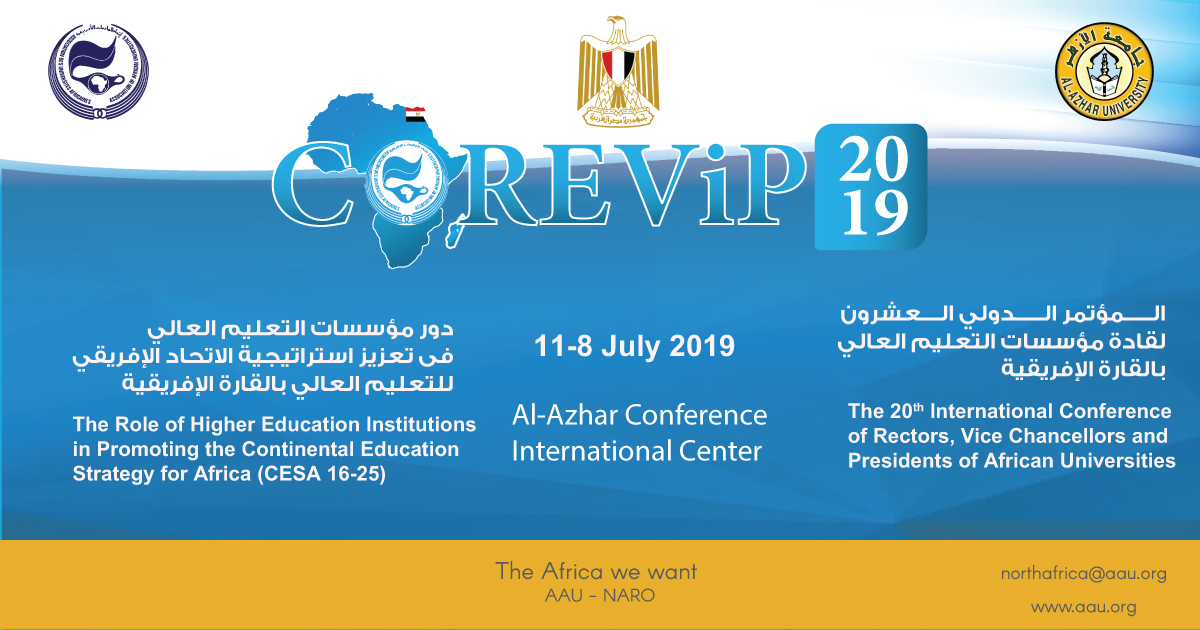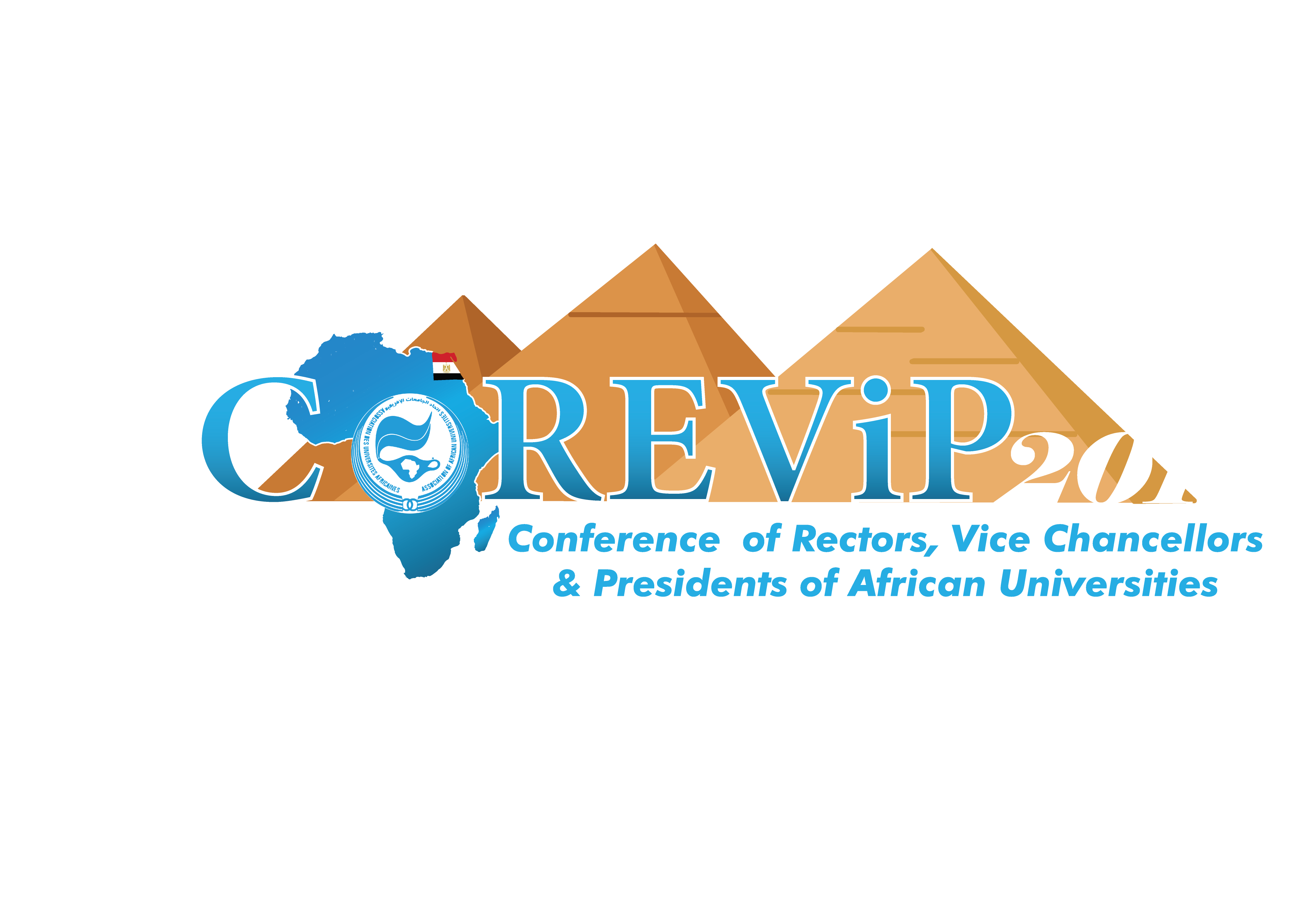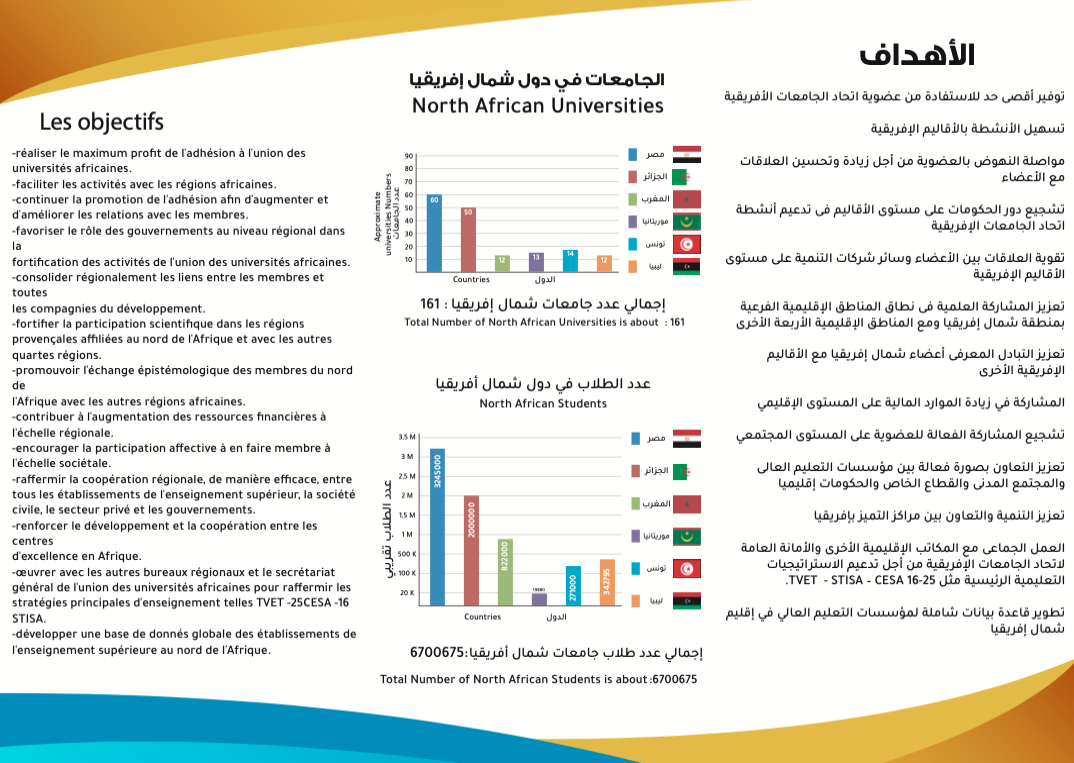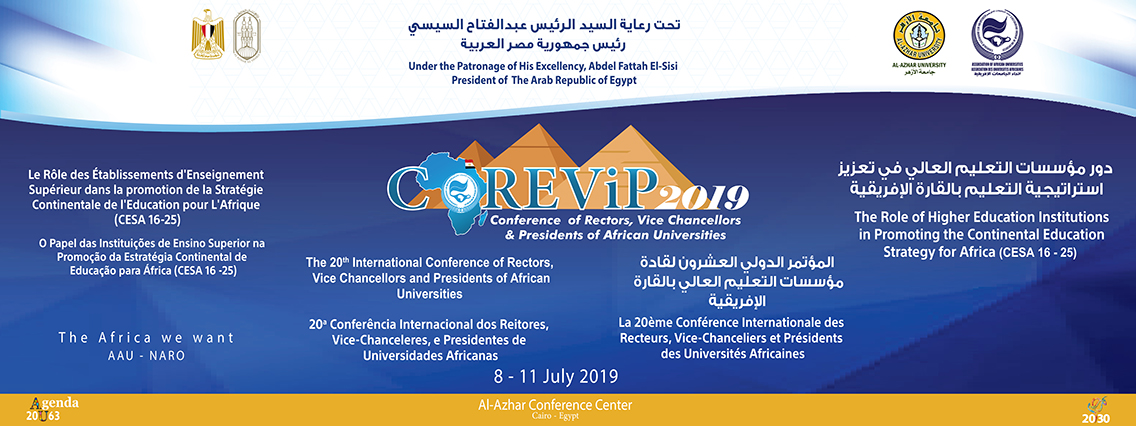
COREVIP 2019
Conference Guide
Theme:
The Role of Higher Education Institutions in Promoting the Continental Education Strategyfor Africa (CESA 16-25)
8 – 11 July 2019
Al-Azhar Conference Center
Cairo - Egypt
By
North Africa Regional Office
AAU NARO
The Role of Higher Education Institutions in Promoting the Continental Education Strategyfor Africa (CESA 16-25)
The Conference of Rectors, Vice-Chancellors and Presidents of African Universities (COREVIP) is an assembly of the Chief Executive Officers of AAU member institutions or their representatives. The Conference is held every two years with the purpose of examining collectively themes identified as common concerns and priorities for the development of higher education in member institutions in particular and Africa in general; making recommendations primarily to members, as well as to the Governing Board of the Association, and to the Secretariat; and acting as a mid-term forum for taking stock of the implementation of the decisions of the General Conference, and recommending corrective actions.
The aim of COREVIP 2019 is to create a congenial environment for harnessing Africa’s best minds and brains in directing efforts to the effective roles which HEIs can and should play in promoting CESA 16-25. The COREVIP 2019 is expected to create awareness, to discuss, identify and strategise on the Theme ‘‘ The Role of Higher Education Institutions in Promoting Continental Education Strategy for Africa (CESA 16-25) ’’. The following COREVIP 2019 sub-themes, which reflect the strategic objectives of CESA 16-25, and become the focus of discussion and networking at the conference, are cross-cutting and overlapping:
Sub-Theme 1: Focus on the science and mathematics curricula in youth training and disseminate scientific knowledge and culture in society.
Given the central role science and mathematics play in the development of a variety of professions and the current focus on the high demand for STEM graduates world-wide, it is important for COREVIP to discuss this sub-theme in relation to new relevant and effective science and mathematics curricula, how to raise the number of teachers who are qualified and proficient in the subjects and the effect these have in increasing the number of youth interested in STEM courses.
Sub-Theme 2: Expand TVET opportunities at tertiary levels and strengthen linkages between the world of work and education and training systems.
How can higher education enhance the expansion of TVET opportunities? How can we make TVET directly relevant to the world of work and training systems? What contribution can HEIs make to mainstreaming and prioritising TVET in secondary schools? How important is it to track the participation of girls and young women as an indication of access to strategic job opportunities in TVET related professions?
Sub-Theme 3: Revitalize and expand tertiary education, research and innovation to address continental challenges and promote global competitiveness.
What priority do African countries give to research and innovation at the tertiary level of education and how can HEIs help to promote and focus attention to retaining and supporting the best brains who graduate annually to remain in HEIs and conduct development-oriented research. Do HEIs have access to enough and adequate funding for research? What new strategies can HEIs develop to attract research funding from all sectors, especially industry.
Sub-Theme 4: Promote peace education and conflict prevention and resolution at all levels of education and for all age groups.
In Africa, more than occurs in other regions of the world, armed conflicts and other forms of wars have caused a lot of havoc in the communities with millions being displaced from their original homes. How do these conflicts affect the development process of a country? Has any government developed and adopted strategies to promote peace and ensure that conflict is prevented at all cost? Are there alternative dispute resolution practices in place in many African countries? Are there strategies that HEIs have helped to develop in their various countries to ensure the continuation of education during armed conflict? To what extent have global citizenship education, education for sustainable development including gender equality and human rights, are mainstreamed in African countries?
Sub-Theme 5: Improve management of education system as well build and enhance capacity for data collection, management, harness the capacity of ICT to improve access, quality and management of education and training systems.
What steps have HEIs taken to support the realisation of SDGs through enhanced capacity for data collection and management, research and scholarship? How do the MIS sections in the various HEIs relate with the ICT division in contributing to the mission and vision of the institutions? What success stories do we have in Africa in the deployment of ICT to enhance access, quality and reduce the cost of education? What obstacles do HEIs encounter in the adoption, adaptation and use of ICT in instruction and training? How does the availability of ICT or lack of it affect the objectives of setting up ODL in the various HEIs in Africa?
Sub-Theme 6: Promoting mobility through harmonization of quality assurance and accreditation systems.
The African Union Commission has for some years now focused on the intra Africa mobility of students and staff and researchers as well as harmonisation of qualifications across the regions of the continent. How have HEIs embraced and implemented these issues? How would the setting up of Quality Assurance mechanisms in the various HEIs assist in the implementation of these issues? What factors count against quality assurance of systems, learning environments and resources across the regions of Africa and how can they be ameliorated?
Sub-Theme 7: Identifying new directions in improving management of education through enhanced capacity for data collection and management, research and scholarship and efficient governance of HEIs in Africa .
What new ways have HEIs developed to improve the management of education through enhanced capacity for data collection and management, research and scholarship in Africa? Do our institutions produce enough professionals to handle EMIS? EMIS is a system for collection, processing, analysis, publication, dissemination and rendering of Information services for the management of educational resources and services. How can the various HEIs assist African governments to use evidence-based decision-making practices for education and training? How can the system check that these educational resources and services are being used for their intended purpose?
Organizers
Association of African Universities (AAU)
Voice of Africa Higher Education
The decision to establish the AAU was taken in September 1963. The founding conference attended by the Heads or Senior representatives of 34 African Universities was held on 12th November 1967 to adopt the constitution and elect AAU Executive Board.
The Association provides a platform for research, reflection, consultation, debates, co-operation and collaboration on issues pertaining to higher education. In addition, the Association provides leadership in the identification of emerging issues and support for debating them and facilitating appropriate follow-up action by its members, partners and other stakeholders.
The association of African Universities (AAU) is a non-profit organization which was founded in 1967 in Rabat, Moracco by the African Universities to promote cooperation among themselves and between the international academic communities.
The AAU contains a group of member academic institutions concerned with higher education and research from all African regions of different languages. The AAU is ambitiously seeking to be the voice of African higher education institutions aiming at enhancing the quality of higher education in Africa as well as to strengthen its contribution in the efforts of achieving development through promotion collaboration among
the AAU members, providing support for their essential tasks represented in teaching, learning, research, engaging in society, enhancing constructive thought and consensus building of views on issues affecting the development in Africa.
Vision
To be the leading advocate for higher education in Africa, with the capacity to provide support for its member institutions in meeting national, continental and global needs.
Mission
To enhance the quality and relevance of higher education in Africa and strengthen its contribution to Africa’s development.
Al- Azhar University
Al-Azhar University is one of the oldest degree-granting university all over the world. As its education mission is runing without any since it was founded in 972 as a centre of education and Islamic learning.
Over centuries, Al-Azhar continued to provide students with knowledge in many fields including Quran, Islamic studies along with sciences like logic, Arabic language sciences, history, social sciences, mathematics, medicine, architecture, and astronomy.
Today, Al-Azhar university contains faculties for medicine, engineering, business, mass communication, bussiness, pharmacy, dentistry, science, agriculture and languages, along with faculties of religious sciences which were established earlier in 1920. In Addition to Al-Azhar University, thousands of elementary and high schools are affiliated with Al –Azhar.
Al-Azhar University pays special attention to education of girls and dedicate branches of the university in several governorates to girls. In the 84 faculties of the university, there are nearly half million students, among them more than 30000 international students from more than one hundred countries, making it the biggest university worldwide.
North Africa Regional Office, NARO
On the 12th March 2019 the North Africa Regional Office of the Association of African Universities was iaugurated in Al-Azhar University in Cairo, Egypt. The mandate of NARO covers 6 countries of North Africa (Egypt, Libya, Tunisia, Algeria, Morocco and Mauritania).
The main objective of NARO is to increase the impact of AAU activities in North Africa and facilitate the activities of AAU membership in subregions. The regional office aims to enhance cooperation and to strengthen relationships among members and related partners. It also aims to improve knowledge sharing as well as visibility and quality of higher education in Africa. It works collectively with other regional offices to support major higher education improvement strategies such as CESA 2016-2025.
NARO objectives
NARO is an integral part of AAU. Through NARO, a new era in Africa Higher Education cooperation is born. NARO is as platform between North Africa and Sub-Saharan Africa, but also between North Africa and East and Middle East and Asia as a whole.
Among the objectives that NARO is seeking to acheive :
- NARO To increase the impact of AAU activities in North Africa
- To maximise the benefits of AAU membership
- To facilitate activities of the membership in the sub-regions in relation with the Secretariat;
- To pursue membership drive in order to increase and improve relations with existing and potential members;
- To enhance the role of governments at the sub-regional level in supporting the activities of the Association;
- To strengthen relationships among members and other development partners at the sub-regional levels;
- To promote knowledge sharing within the North African sub-region and with the other 4 sub-regions;
- To improve information sharing within members in the sub-region;
- To engage in fund-raising and resource mobilisation at the sub-regional level;
- To encourage active participation of the membership at the Community level;
- To actively promote collaboration among academia, civil society, private sector and governments at the sub-regional level;
- To promote development of and collaboration among Centres of Excellence in Africa;
- To work collectively with the other regional offices and the AAU Secretariat to support major educational strategies such as the CESA 16-25, STISA, TVET
- To develop a comprehensive database of Higher Education Institutions in the sub-region.
Participating Universities and Institutions*
Country
Institution
1.
Algeria
Abou Bekr Belkaid
2.
Universty of batna
3.
Benine
University of Abomeyi-Calavi
4.
Botswana
Botho University
5.
Burundi
University of Burundi Doctoral School
6.
International University of Equator
7.
Cameron
Institut universitaire du Golfe de Guinée (IUG)
8.
University of Ngaoundere
9.
Université de Maroua
10.
University of Buea
11.
University of Yaoundé 2
12.
The University of Bamenda
13.
Universite de Kinshasa
59.
Ethiopia
Arsi University
60.
St. Mary's University
61.
Pan African University
62.
Almarifa Foundation for education & training
63.
Education Strategy Center Addis Ababa
64.
European Union
Discovery Learning Alliance
65.
Education, Audiovisual and Culture Executive Agency (EACEA)
66.
European Commission - EACEA
67.
European Universities Association (EUA)
68.
Gambia
Euclid University
69.
American International University West Africa gambia
70.
University of The Gambia
71.
Ministry of Education
72.
Germany
GFA
73.
German Academic Exchange Service (DAAD)
74.
Ghana
University of Ghana
75.
Kwame Nkrumah University of Science and Technology
76.
University of Education, Winneba
77.
University of Professional Studies Accra
78.
Ghana Institute of Management and Public Administration (GIMPA)
79.
Accra institute of Technology
80.
University of Health and Allied Sciences, Ho
81.
University of Cape Coast
82.
University College of Science and Technology
83.
Islamic University College
84.
Ministry of Higher Education, Research, Science and Technology
85.
Minister of Trade and Industry
86.
Legon Centre for International Affairs and Diplomacy (LECIAD)
87.
Ghana Armed Forces Command & Staff College
88.
The Centre for International Education and Collaboration
89.
Shardfo-Tech Company Limited
90.
Ghana Institute of Management and Public Administration (GIMPA)
91.
Parliament of Ghana
92.
India
Amity University
93.
King Baudouin Foundation United States
94.
International
Institutions
University World News
95.
UNESCO
96.
African Union
97.
USAID
98.
Asda Stores Ltd
99.
Global Placements
100.
Organization for Women in Science in the Developing World
101.
Marie Curie Alumni Association (MCAA)
102.
International Network for Higher Education in Africa
103.
International TVET (Support to the Technical Vocational Education and Training Reform Programme)
104.
Human Resources, Science and Technology (HRST)
105.
International Network for Higher Education in Africa
106.
The International Council for Small Business (ICSB)
107.
Agence universitaire de la Francophonie (AUF)
108.
Education Sub Saharan Africa
109.
African Union Commission
110.
Professional Education
Middle East & Africa SIEMENS
111.
Jordan
SESAME Facility
112.
Kenya
Technical University of Kenya
113.
Kisii University
114.
Maseno University
115.
United States International University-Africa
116.
University of Nairobi
117.
Kibabii University
118.
Research Beeline
119.
Lesotho
National University of Lesotho
120.
Malawi
Telecom Network Malawi (TNM)
121.
Mauritius
University of Mauritius
122.
Morocco
Cadi Ayyad
123.
Mozambique
Eduardo Mondlane University
124.
Namibia
Monitronic Success College
125.
Nigeria
Adekunle Ajasin University
126.
Admiralty University of Nigeria (ADUN)
127.
Ambrose Alli University
128.
Augustine University
129.
Baze University, Abuja.
130.
Caleb University
131.
Crawford University
132.
Delta State University, Abraka
133.
Federal University Lafia
134.
Federal University of Agriculture Abeokuta
135.
Federal University of Agriculture, Makurdi, Nigeria
136.
Federal University of Technology Minna
137.
Gombe State University
138.
Ibrahim Badamasi Babangida University
139.
Igbinedion University, Okada
140.
Imo State University
141.
Kwara State University
142.
Lead City University
143.
Michael Okpara University of Agriculture
144.
Mountain Top University, Nigeria
145.
National open University of Nigeria
146.
Niger Delta University
147.
OSUN State University
148.
Rivers state University
149.
Sule Lamido University
150.
Umaru Musa Yaradua University
151.
University Abdou Moumouni de Niamey
152.
University of Benin
153.
University of Calabar, Calabar
154.
University of Glasgow
155.
University of Ibadan
156.
University of IIorin
157.
University of Jos
158.
University of Maiduguri
159.
University of Port Harcourt
160.
Asda Stores Ltd
161.
Botosoft Technologies Ltd
162.
African Union
163.
Committee of Vice Chancellors of Nigeria
164.
Global Network for Environment and Economic Development Research (GNEEDER)
165.
Opelawy Intl Services Limited
166.
The Nation (Vintage Press Limited)
167.
Rwanda
University of Rwanda
168.
Sierra Leone
Njala University
169.
Somalia
SIMAD University
170.
Plasma University
171.
Mogadishu University
172.
Abrar University, Mogadishu, Somalia
173.
University of Hargeisa
174.
Global Observatory
175.
Ministry of Education and Science
176.
South Africa
Stellenbosch University
177.
University of Pretoria
178.
University of Venda
179.
Sefako Makgatho Health Science University
180.
University of Johannesburg
181.
Sol Plaatje University south Africa
182.
University of Cape Town and Organization for Women in Science in the Developing World
183.
South Sudan
University of Juba
184.
Sudan
Bakht Alruda University
185.
Elemam Elmahdi University
186.
Nile Valley University
187.
Nobles College of Science and Technology
188.
Omdurman Islamic university
189.
Sudan International University
190.
University of al Fashir
191.
University of al-butana
192.
University of Bahri
193.
University of Zalingei
194.
Sweden
Swedish International Development Cooperation Agency
195.
Tanzania
Open University of Tanzania
196.
University of Dar es Salaam
197.
Uganda
Kyambogo University
198.
Makerere University
199.
National Agricultural Research Organization
NARO
200.
Uganda Management Institute
201.
United Kingdom
University of Nottingham
202.
203.
United States of America
University of Michigan
204.
American Society for Engineering Education (ASEE).
205.
Association of African Universities
206.
Mathematical and Physical Sciences (MPS)
207.
Zambia
Copperbelt University
208.
University of Lusaka
209.
Supershine University
210.
Zimbabwe
Bindura University of Science Education
211.
Great Zimbabwe University
212.
Gwanda State University
213.
Lupane State Univeristy
214.
Marondera University of Agricultural Sciences and Technology
215.
Midlands State University
216.
National University of Science and Technology
217.
ZIMCHE (Zimbabwe Council for Higher Education)
218.
Mauritania
Graduate School of Education, Nouakchott
219.
Libya
University of Benghazi
220.
Sabha University
221.
Sirte Univwesity
222.
Al-Zintan Uiversity
223.
Al Asmarya University
*This is the available data up to date of printing the guide
Cairo Tourist Attractions
Giza pyramid complex
The Giza pyramid complex, also called the Giza Necropolis, is the site on the Giza Plateau in Egypt that includes the Great Pyramid of Giza , the Pyramid of Khafre , and the Pyramid of Menkaure , along with their associated pyramid complexes and the Great Sphinx of Giza . All were built during the Fourth Dynasty of the Old Kingdom of Ancient Egypt . The site also includes several cemeteries and the remains of a workers' village. The site is at the edges of the Western Desert , approximately 9 km (5 mi) west of the Nile River in the city of Giza, and about 13 km (8 mi) southwest of the city center of Cairo.
Sound and Light Show at Giza
After the sun sets on the bustling city of Cairo, the famous pyramids on the Giza plateau come to life in a magical sound and light setting. A not to be missed experience: the show narrates Ancient Egypt in an enchanting atmosphere and the history of these mysteriously built gigantic structures.
Khan el-Khalili
No visit to Cairo is Complete without a stop at the Khan El-Khalili bazaar, where you will be transported back in time to an old Arab souk. Shop owners calling you to their stalls, the scent of spices, the hustle and bustle of trade, and the many beautiful objects that can purchased will have you lost among alleys for hours. Put your haggling skills to the test when buying statuettes, spices, souvenirs, silver jewelry, t-shirts, galabiyyas, belly dancing costumes, or anything for that matter. When your shopping's done, don’t miss out on a traditional cup of tea at the famous Fishawi's cafe.
Salah El-Din Citadel in Cairo
The Salah El-Din Citadel is one of the world's greatest monuments to medieval warfare. Resembling a typical early medieval fortress, with large imposing gateways, towers and high defending walls, the Citadel is one of Cairo's main attractions and probably the most popular non-pharaonic monument in the Egyptian capital. The prominent fortress houses three mosques - of which the impressive Mohamed Ali Mosque - a carriage museum, a military museum, and a garden museum, just to name a few, and they are all worth a visit. You are even allowed the run of the fortifications and it is worth a try: the views are spectacular from this height. The citadel is also home to the impressive Gawhara Palace (the Jewel Palace), named after Gawhara Hanem, Mohamed Ali's last wife. Built in 1814, it housed the ruler's administration and was used as a personal residence by the Egyptian leader. Beautiful gold inscriptions adorn the walls of this majestic Ottoman-influenced palace. One of its most eccentric components is the Watch Hall, where the shape of a watch has been used to decorate the walls.
Sultan Hassan Mosque and Madrassa
The Mosque-Madrassa of Sultan Hassan is regarded as the finest piece of early-Mamluk architecture era in Cairo, an age of architectural splendor. Story has it that the construction of this complex was a tedious and tragic process. In fact, it was built between 1356 and 1363 by the Sultan Hassan who was murdered shortly before the mosque was completed. Sultan Hassan's madrassa-mosque was built out of huge blocks of stone. Due to its tremendous height, this mosque soon became a symbol of the culmination of all the architectural power developed throughout a century of Mamluk rule. When arriving to the mosque, your eyes will be immediately drawn upward into the blue sky. And as you lower your head, you will witness the most amazingly patterned mosaic-paved courtyard, unprecedented in Cairo. Only a glimpse of the splendor you'll gaze at inside
Nile Cruise
Nile River , Arabic Nahr Al-Nīl, the longest river in the world, called the father of African rivers. It rises south of the Equator and flows northward through northeastern Africa to drain into the Mediterranean Sea .
The Egyptian Museum
With over 120,000 artifacts, the museum houses an unbelievable exhibit depicting ancient Egypt's glorious reign. Mummies, sarcophagi, pottery, jewelry and of course King Tutankhamen's treasures, it's all there. The boy-king's death-mask - discovered in its tomb - is made of solid gold and it has been described as the most beautiful object ever made.
The Coptic Museum
See the distinctive blend of cultures at the Coptic Museum in Cairo where are displayed hundreds of Christian Egyptian documents, statues and artifacts in which you'll distinct Ancient Egyptian, Greek, Roman, Byzantine and Ottoman influence. Take a breath of fresh air in a peaceful courtyard surrounded by green gardens when you need to relax. The Coptic Museum is located within the Roman fortress town called Babylon in Old Cairo, step into the past and walk by the fusion of cultures inside and outside the museum in a place as old as history.
Museum of Islamic Art
Displaying over 10,000 articles dating back to the Islamic era in Egypt, this is one place you don't want to miss while in Cairo. Marvel at the giant carved wooden doors or the tiny, intricate copper sculptures. With exhibitions from every Islamic period in Egypt, it covers the Fatimids, the Mamluks, the Abbassids, the Ummayads, the Ottomans, and the Ayyubbids dynasties.
Al-Azhar Mosque
Located at the heart of Islamic Cairo, the Al-Azhar complex, mosque and university, does not only house the oldest university in the world but it is also the place where the graduation black gowns originated from. The costume worn by students all around the world during their graduation seems to have been inspired by the flowing robes of the Islamic Scholars 'graduating' from Al-Azhar. The University is now distributed between different buildings, but the mosque, founded by Jawhar al-Siqilly, the Fatimid conqueror of Egypt, in 970 is still a true marvel and a not-to-be-missed attraction while visiting Cairo. Moreover, due to its location, it is the perfect place to start your exploration tour of Islamic Cairo
Mosque of Amr Ibn Al-'As
Built in 642 AD with palm trunks and fronds, it was the first mosque erected in Egypt and all Africa. The location of the mosque was determined by the general of the Muslim Army Amr Ibn Al-'As who had pitched his tent at that very same place when he conquered the land. The capital of Islamic Egypt Al-Fustat was then built around this spot. There are approximately 200 columns in the mosque taken from different sites, and the wide and quiet spaces offer a sanctuary from the bustle of Cairo. The mosque of Amr Ibn Al 'As is part of what is commonly known today as the \"Multi-Religious Compound\" in Cairo, an area that is home to very old places of worship pertaining to the three monotheistic religions: Islam, Christianity, and Judaism.
Saqqara Step Pyramid
Said to be the world's oldest monumental masonry structure, the unique pyramid of Djoser in Saqqara is part of a mortuary complex for the 3rd Dynasty king Djoser. Created by the architect Imhotep, it is a unique stepped pyramid with 6 tiers. The blue tiles of Djoser's tomb, the hieroglyphs in the pyramid of Pepi I, and the Doors of the Cats (Abwab el Qotat) are all breathtaking scenes.
The Hanging Church

Take the steps that lead to one of the most beautiful churches in the Middle East known as the Hanging Church. Built on top of the Roman fortress gatehouse called Babylon, the nave of the Hanging Church is suspended over the passageway. Located just south of the Coptic Museum in Cairo, the Hanging Church boasts 13 magnificent pillars in its interior, representing Jesus and his 12 apostles. Listen in on the ancient liturgical Coptic language used in service and witness a living vestige of Ancient Egyptian history.
Ben Ezra Synagogue
This was the synagogue whose geniza or store room was found in the 19th century to contain a treasure of abandoned Hebrew, Aramaic and Judeo-Arabic secular and sacred manuscripts. The collection, known as the Cairo Geniza , was brought to Cambridge, England at the instigation of Solomon Schechter and is now divided between several academic libraries.
El-Moez Street

El-Moez Street is one of Cairo's most remarkable historic places, giving you a glimpse of old Cairo. It is an outstanding street that was known in Islamic Cairo as Al Moez Ldin Allah Al Fatimi Street. The street is named after the fourth Caliph of the Fatimid Dynasty and the 14th Ismaili imam who reigned from 953 to 975, Al Moez Ldin Allah Al Fatimi. Its location starts from Bab Al-Futuh in the north to Bab Zuweila in the south. The national government held some renovations in the structure of the street and to the buildings inside it making the street look like an open museum for tourists.
Important Numbers
In case of emergency NARO regional office 01552104529
call: Prof. Amany ELsherif 01110660444
Dr. Mohammad Atteya 01002363199
Prof. Heba Zahaby 01007520490
If you have problems Dr. Abdulrahman 01097092444 with transportation Dr. Islam 01010925975 call: Mr. Ismael 01068336676
Mr. Ahmed 01158846803
Mr. Mahmoud 01093722606
If you have problems Dr. Sherine Emara 01275750210 with accommodation Ms. Mariam 01004820779
call: Ms. Rawda 01064055152
If you have problems Dr. Ibrahim 01286880912
with tours call:
If you face
Health Emergency Dr. Azza Farouk 01063362625
call
Addresses
Tolip Family Park Hotel
Cairo Suez Road - Km 26, Rehab - ENtrance Gate (2)
Tel : 02 24775250
Tolip Golden Plaza Hotel
Omar Ibn El khattab Street, Nasr City, City Stars Area
Tel: 02 26910800
Tolip El Narges Hotel
Southern 90 St, Fifth District, Cairo, Egypt
Tel : 02 26170000
Lamar Hotel
Al Fangari, Beside Mansheyat Al Bakri، Heliopolis, Cairo


